9.2 Transcription
Central Dogma
Protein synthesis, the production of proteins, occurs in all living things’ cells. It uses the information in DNA to make corresponding proteins.
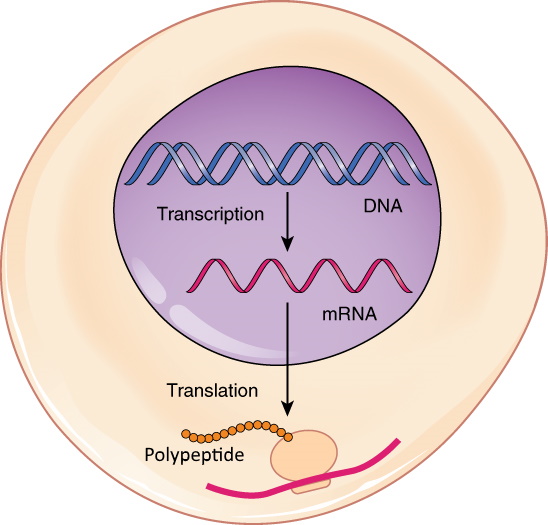
In eukaryotic cells, DNA is found in chromosomes, which always remain in the nucleus. Proteins are made at ribosomes in the cytoplasm. How do the instructions in DNA get to the site of protein synthesis outside the nucleus?
Another type of nucleic acid is responsible – RNA or ribonucleic acid. RNA is a small molecule that can squeeze through pores in the nuclear membrane. It carries the information from DNA in the nucleus to a ribosome in the cytoplasm and then helps assemble the protein.
In short: DNA → RNA → Protein
DNA is used as a template during transcription to make a messenger RNA molecule (mRNA). During translation, mRNA is read and used to link amino acids together to make a polypeptide. This sequence of events is called the central dogma of molecular biology.
Figure 9.2.1 Description
Diagram of gene expression in a eukaryotic cell. Inside the nucleus, DNA undergoes transcription to produce mRNA. The mRNA exits the nucleus and is used in the cytoplasm for translation, resulting in the formation of a polypeptide chain.
Structure of RNA
DNA alone cannot “tell” your cells how to make proteins. It needs the help of RNA, the other leading player in the central dogma of molecular biology. Like DNA, RNA is a nucleic acid consisting of repeating nucleotides bonded together to form a polynucleotide chain. RNA differs from DNA in several ways: it exists as a single-stranded molecule, contains the sugar ribose (as opposed to deoxyribose) and uses the base uracil instead of thymine.
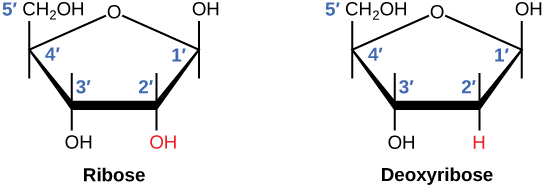
Figure 9.2.2 Description
Side-by-side comparison of the chemical structures of ribose and deoxyribose sugars. Both have a five-carbon ring labelled with carbon positions (1′ to 5′), but ribose has a hydroxyl group (OH) at the 2′ carbon, while deoxyribose has only hydrogen (H) at the same position.

Functions of RNA
The main function of RNA is to help make proteins. There are three main types of RNA involved in protein synthesis:
- Messenger RNA (mRNA) copies (or transcribes) the genetic instructions from DNA in the nucleus and carries them to the cytoplasm.
- Ribosomal RNA (rRNA) helps form ribosomes, where proteins are assembled. Ribosomes also contain proteins.
- Transfer RNA (tRNA) brings amino acids to ribosomes, where rRNA catalyzes the formation of chemical bonds between them to form a protein.
The diversity of roles that RNA molecules play has led to their being called the Swiss Army knives of the cellular world.
Figure 9.2.3 Description
Diagram showing the three main types of RNA. At the top is messenger RNA (mRNA), represented as a squiggly single strand. In the middle is ribosomal RNA (rRNA), illustrated as part of a ribosome complex with two subunits. At the bottom is transfer RNA (tRNA), shown as a cloverleaf structure with an attached amino acid.
Exercises 9.2.1
Text Description
Comparison of DNA and RNA
Drop Zones:
- DNA
- RNA
Possible Answers
- Stores genetic information
- Can be found throughout the cell
- Can be used to carry information, carry amino acids, make up ribosomes
- Contains ribose
- Double stranded
- Single stranded
- Contains deoxyribose
- Contains thymine
- Contains uracil
- Remains in the nucleus
Answers
DNA:
- Double stranded
- Contains deoxyribose
- Contains thymine
- Remains in the nucleus
- Stores genetic information
RNA:
- Single stranded
- Contains ribose
- Contains uracil
- Can be found throughout the cell
- Can be used to carry information, carry amino acids, make up ribosomes
Text Description
mRNA is ____ from DNA, and then is ____ into a protein.
____ exits the nucleus through a nuclear pore. ____ helps form the structure where proteins are assembled. ____ transports amino acids to the ribosome.
Answers
mRNA is transcribed from DNA, and then is translated into a protein.
mRNA exits the nucleus through a nuclear pore. rRNA helps form the structure where proteins are assembled. tRNA transports amino acids to the ribosome.
Transcription
Transcription is the first part of the central dogma of molecular biology: DNA → RNA. It is the transfer of genetic instructions in DNA to mRNA. During transcription, a strand of mRNA is made to complement a strand of DNA.
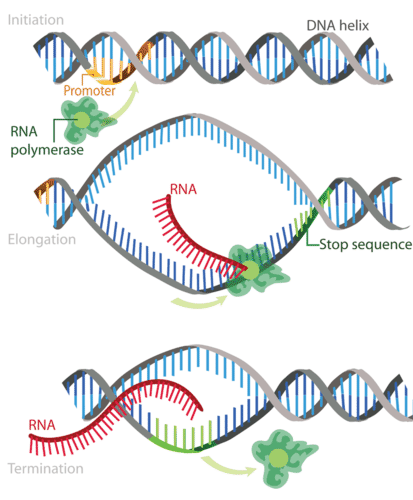
Figure 9.2.4 Description
Illustration of the transcription process in three stages: initiation, elongation, and termination. In initiation, RNA polymerase binds to the promoter region of DNA. In elongation, the DNA unwinds, and RNA polymerase synthesizes a complementary RNA strand. In termination, the RNA strand detaches and the DNA rewinds.
Transcription occurs in three main steps:
1. Initiation
Transcription begins when the enzyme RNA polymerase binds to a gene region called the promoter sequence. This signals the DNA to unwind so the enzyme can “read” the bases of DNA. The region of unwinding is called a transcription bubble.
In most cases, promoters exist upstream of the genes they regulate. The specific sequence of a promoter is very important because it determines whether the corresponding gene is transcribed all of the time, some of the time, or hardly at all.
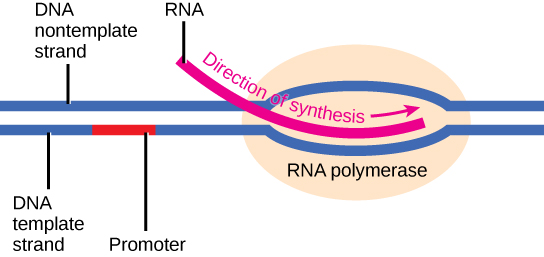
Figure 9.2.5 Description
Diagram of transcription initiation showing RNA polymerase binding to the DNA template strand at the promoter region. The DNA non-template strand is also shown. RNA synthesis begins at the promoter, and the RNA strand is elongated in the 5′ to 3′ direction.
2. Elongation
RNA polymerase moves along the template strand of DNA, unwinds the double helix, synthesizes mRNA, and then rewinds the DNA. RNA polymerase adds RNA nucleotides to the growing mRNA strand through complementary base pairing. When the DNA has “T”, RNA polymerase adds in “A”. “C” in the DNA corresponds to “G” in RNA. “G” in DNA to “C” in RNA. When RNA polymerase reaches “A” in the DNA, it adds in “U” (because there is no “T” in RNA).
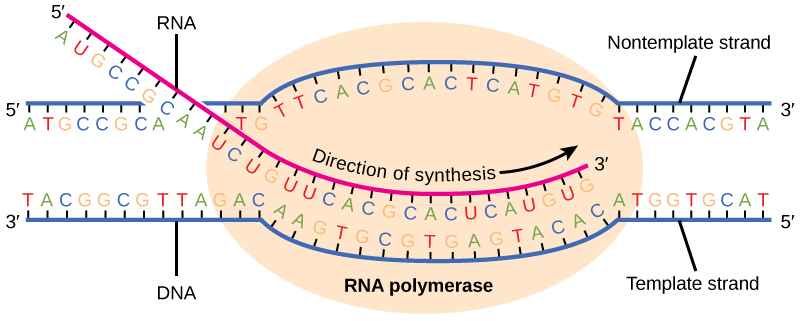
Figure 9.2.6 Description
Diagram of RNA transcription showing RNA polymerase moving along the DNA template strand in the 3′ to 5′ direction. The RNA strand is synthesized in the 5′ to 3′ direction, complementary to the DNA template strand. The DNA non-template strand is also shown, with all base pairs labelled.
3. Termination
RNA polymerase reaches a special region in the DNA called the terminator sequence, which signals the end of the gene. At this point, RNA polymerase stops transcription, detaches from the DNA template, and releases the mRNA transcript. The result is a strand of mRNA that is complementary to the DNA template strand and nearly identical to the nontemplate strand – the only difference being that DNA uses the base thymine (“T”), and the mRNA uses uracil (“U”) instead.
Processing mRNA
The newly transcribed eukaryotic mRNAs must undergo several processing steps before they can be transferred from the nucleus to the cytoplasm and translated into a protein. The additional steps involved in eukaryotic mRNA maturation create a molecule that is much more stable than a prokaryotic mRNA. For example, eukaryotic mRNAs last for several hours, whereas the typical prokaryotic mRNA lasts no more than five seconds.
The processing may include splicing, adding a cap, and adding a tail, among other possible modifications.
- Splicing: Eukaryotic genes comprise exons (protein-coding sequences) and introns (regions that do not code for the protein). Splicing removes introns from mRNA. It is essential that all of a pre-mRNA’s introns are completely and precisely removed before protein synthesis so that the exons join together to code for the correct amino acids. If the process errs by even a single nucleotide, the sequence of the rejoined exons will be shifted, and the resulting protein will be nonfunctional.
- Capping: A special nucleotide cap is added to the “head” (5’ end) of the mRNA. This cap protects the mRNA from breaking down and helps the ribosomes know where to bind to the mRNA.
- Polyadenylation: A poly-A tail, consisting of approximately 200 adenine bases, is added to the “tail” (3’ end) of the mRNA. It signals the end of mRNA, exports mRNA from the nucleus, and protects mRNA from enzymes that might break it down.
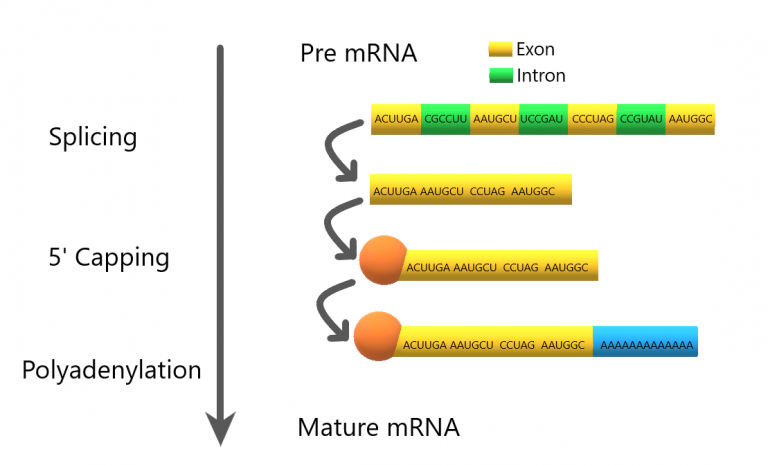
Figure 9.2.7 Description
Diagram illustrating the processing of pre-mRNA into mature mRNA. The pre-mRNA contains both exons (yellow) and introns (green). The first step is splicing, where introns are removed. Next, a 5′ cap is added to the beginning of the mRNA. Finally, a poly-A tail is added to the 3′ end. The result is mature mRNA ready for translation.
Exercise 9.2.2
Text Description
1. What is a promoter?
- a specific sequence of DNA nucleotides
- a specific sequence of RNA nucleotides
- a protein that binds to DNA
- an enzyme that synthesizes RNA
2. What portions of eukaryotic mRNA sequence that are removed during RNA processing?
- exons
- caps
- poly-A tails
- introns
Answers
- a specific sequence of DNA nucleotides
- introns
“5.5 RNA” from Human Biology by Christine Miller is licensed under a Creative Commons Attribution-NonCommercial 4.0 International License, except where otherwise noted.
“5.7 Protein Synthesis” from Human Biology by Christine Miller is licensed under a Creative Commons Attribution-NonCommercial 4.0 International License, except where otherwise noted.
“9.3 Transcription” from Biology and the Citizen by Colleen Jones is licensed under a Creative Commons Attribution 4.0 International License, except where otherwise noted.

